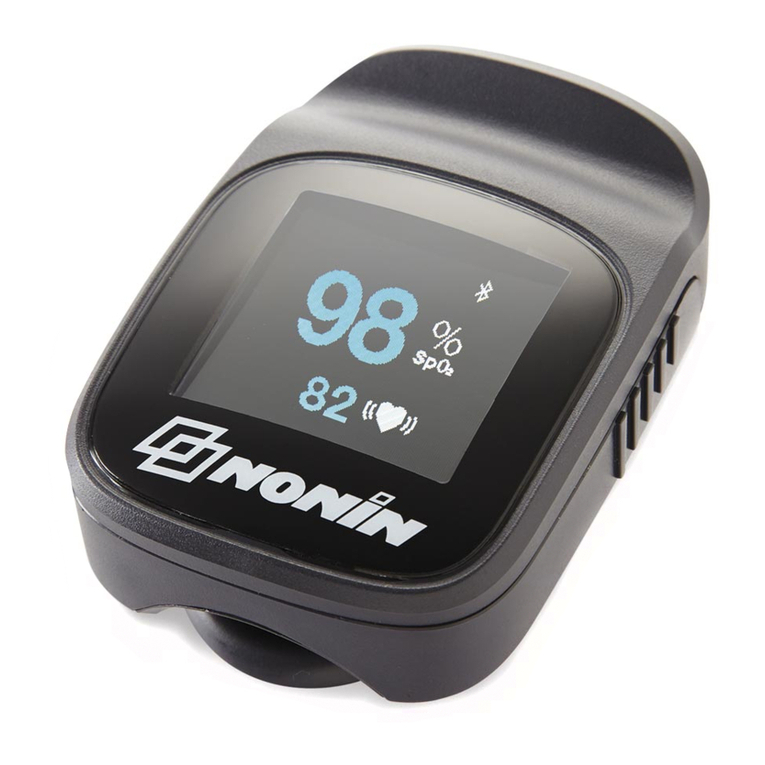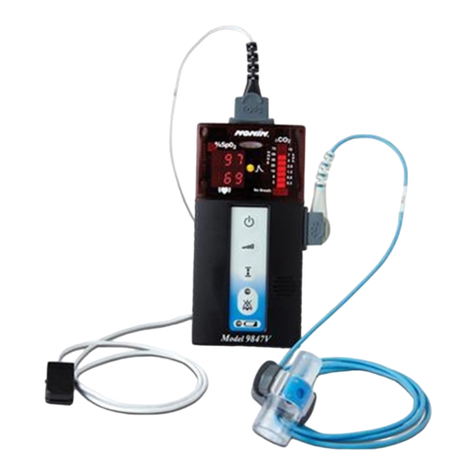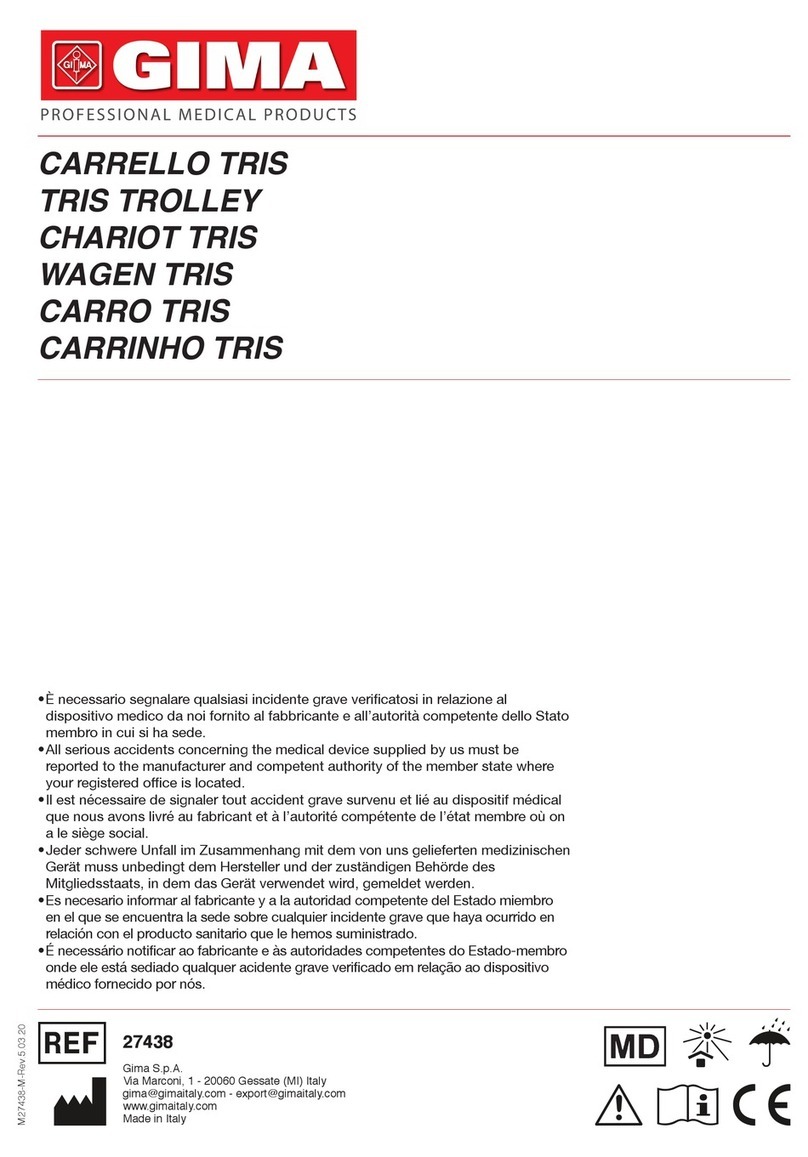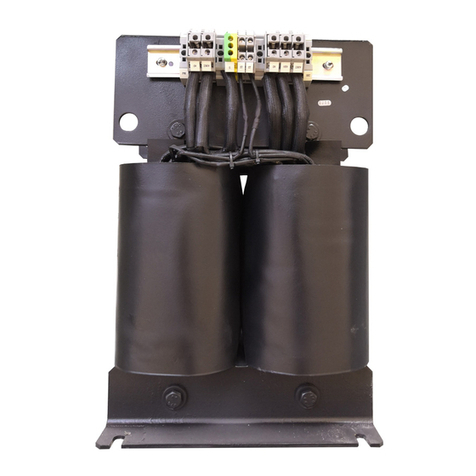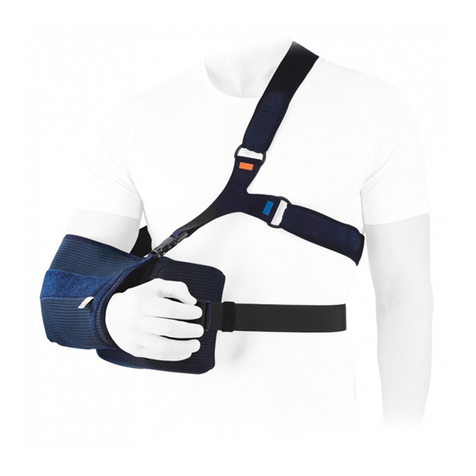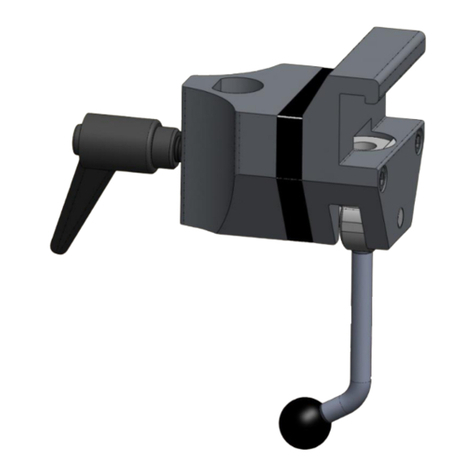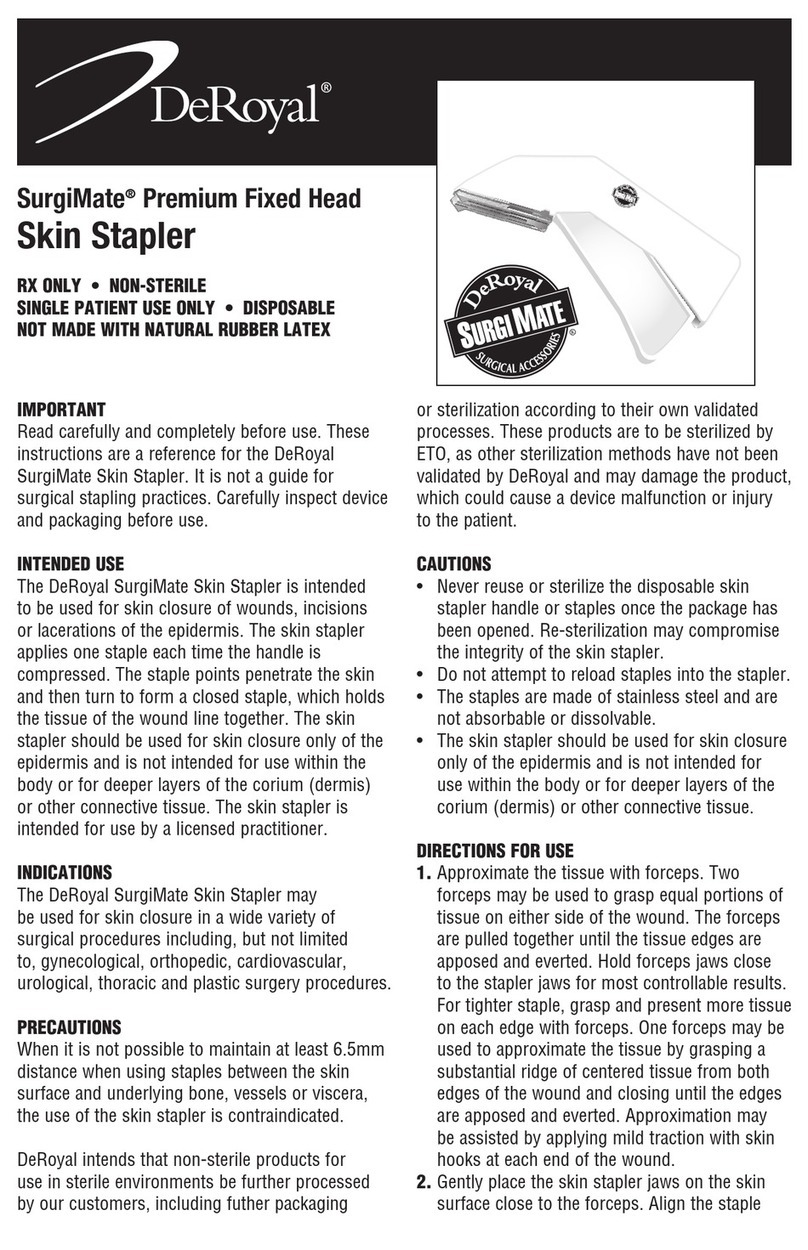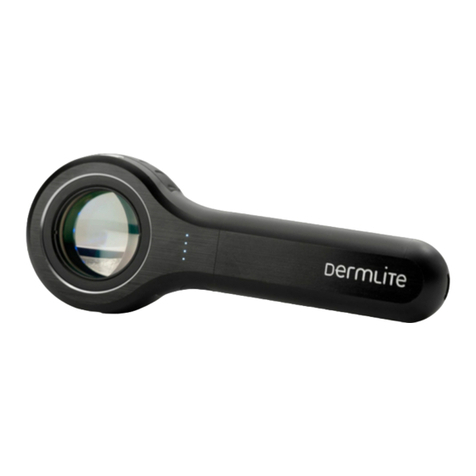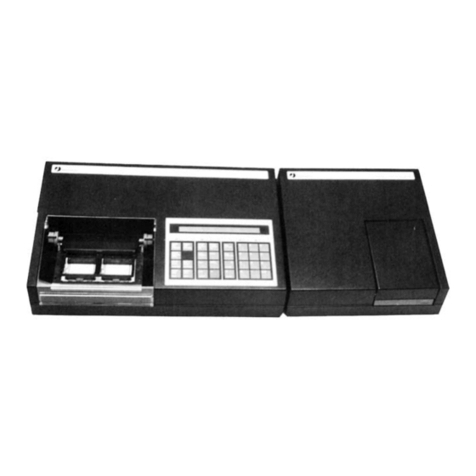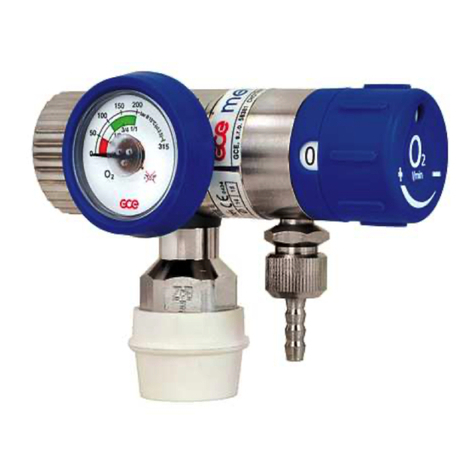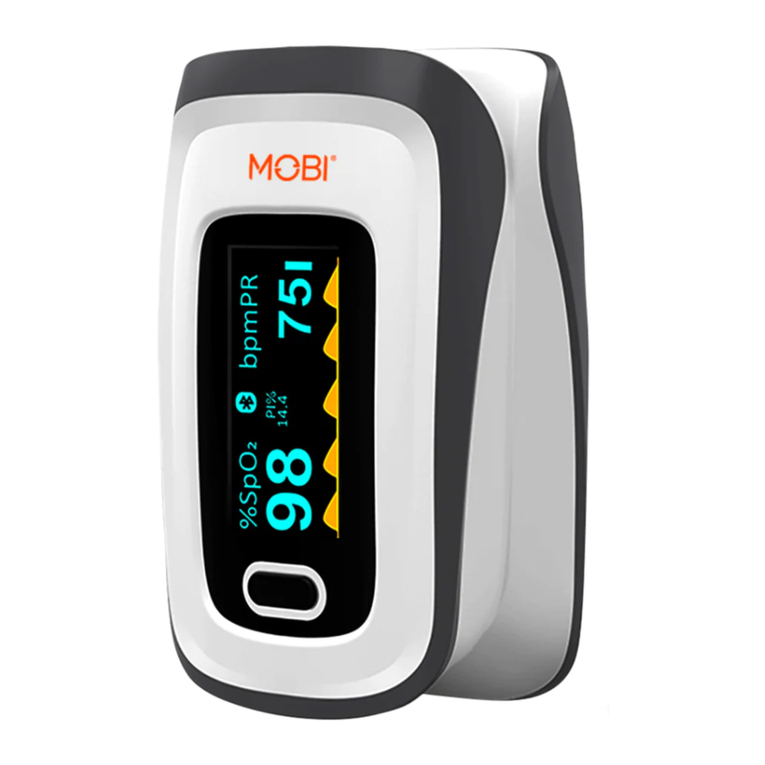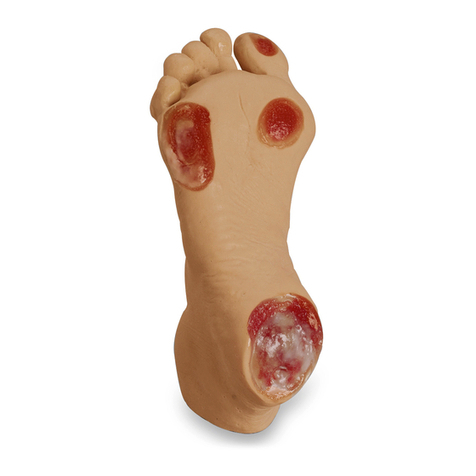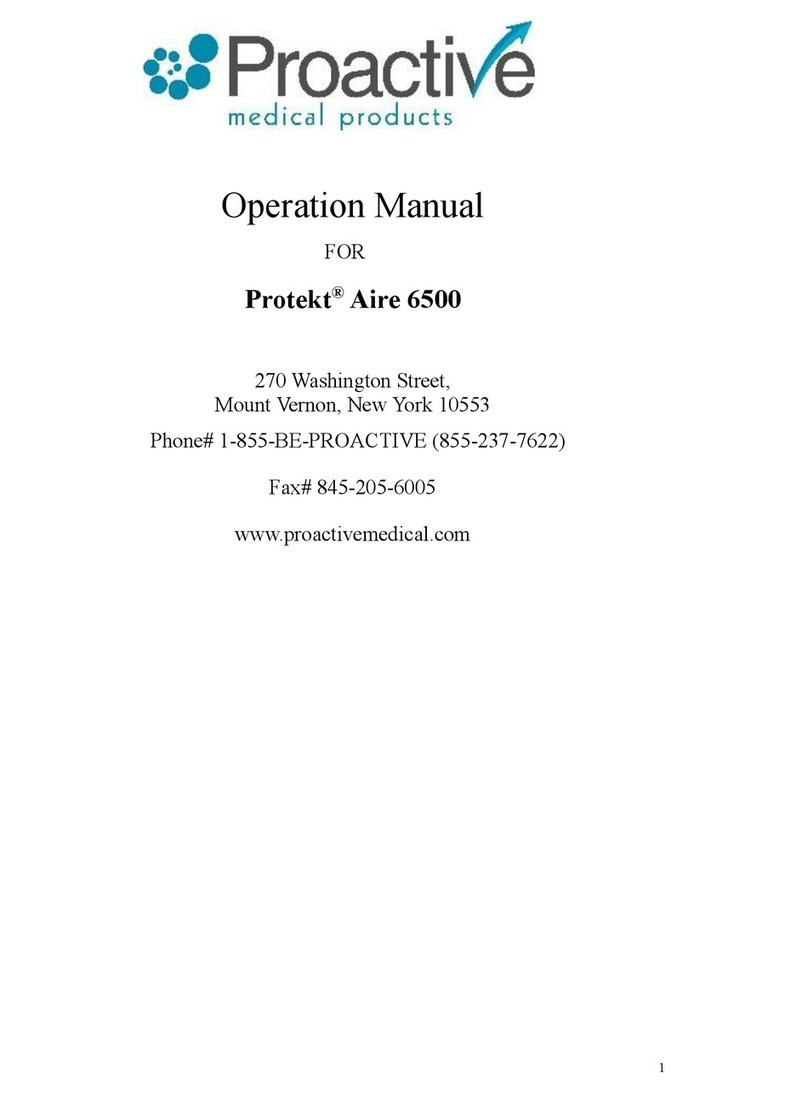Nonin 7500 User manual

Operator’s Manual
Digital Pulse Oximeter
Model 7500
Model 7500
1
0123
English

The information in this manual has been checked carefully and is
believed to be accurate. In the interest of continued product
development, NONIN reserves the right to make changes and
improvements to this manual and the products it describes at any time,
without notice or obligation.
Nonin Medical, Inc.
13700 1st Avenue North
Plymouth, Minnesota 55441-5443
USA
+1 (763) 553-9968
(800) 356-8874 (USA and Canada)
Fax +1 (763) 553-7807
mail@nonin.com
www.nonin.com
Authorized EC Representative:
MPS, Medical Product Service GmbH
Borngasse 20
D-35619 Braunfels, Germany
References to “NONIN” in this manual shall imply Nonin Medical, Inc.
Nonin is a registered trademark of Nonin Medical, Inc.
© 2007 Nonin Medical, Inc.
5676-001-01
CAUTION: Federal law (USA) restricts this device to sale by or on the order of
a licensed practitioner.
Consult Instructions for Use.
EC
REP

i
Contents
Contents
Guide to Symbols ......................................................................1
Indications for Use ....................................................................3
Contraindications ............................................................................ 3
Warnings ......................................................................................... 3
Cautions .......................................................................................... 4
Displays, Indicators and Controls ...........................................7
Operating the Model 7500 ......................................................10
Operating Modes and Defaults ..............................................11
Setup Mode, Viewing Limits and Setting Time ............................. 11
Factory Defaults ............................................................................ 11
User-Defined Defaults .................................................................. 12
Patient Security Mode ................................................................... 12
Operator Functions .................................................................14
Care and Maintenance ............................................................18
Cleaning the Model 7500 .............................................................. 18
Alarms and Limits ...................................................................19
High Priority Alarms ...................................................................... 19
Medium Priority Alarms ................................................................. 19
Watchdog Alarms ......................................................................... 19
Informational Tones ...................................................................... 19
Alarm Summary ............................................................................ 20
Reviewing and Setting Volume and Alarm Limits ................21
Silencing Alarms ........................................................................... 21
Recalling Previous Settings .......................................................... 22
Error Codes .................................................................................. 22
Memory and Data Output Features .......................................23
Serial Patient Data Output ............................................................ 23
Analog Output ............................................................................... 24
Memory Features .......................................................................... 25
Service, Support, and Warranty .............................................27
Warranty ....................................................................................... 28
Parts and Accessories ............................................................29
Troubleshooting ......................................................................31
Technical Information .............................................................34
Manufacturer’s Declaration ........................................................... 34
Equipment Response Time .......................................................... 38
Testing Summary .......................................................................... 39
Specifications ................................................................................ 40
1

1
Guide to Symbols
Guide to Symbols
This table describes the symbols that are found on the Model 7500.
Detailed information about functional symbols can be found in “Operating
the Model 7500.”
Symbol Description
Caution!
Consult instructions for use.
Type BF Applied Part (Patient isolation from electrical shock).
UL Mark for Canada and the United States with respect to
electric shock, fire, and mechanical hazards only in accordance
with UL 60601-1 and CAN/CSA C22.2 No. 601.1.
CE Marking indicating conformance to EC directive No. 93/42/
EEC concerning medical devices.
Serial Number
Indicates separate collection for electrical and electronic
equipment (WEEE).
Authorized Representative in the European Community.
Lot Number
IPX2 Protected against vertically falling water drops when enclosure
is tilted up to 15 degrees, per IEC 60529.
%SpO2%SpO2display.
Pulse Rate Display.
Numeric LEDs
!
C
L
A
S
S
I
F
I
E
D
U
S
CUL
0123
SN
EC
REP

2
Guide to Symbols
Alarm Bar LED.
Pulse Quality LED.
Sensor Alarm LED.
Pulse Strength Bargraph LED.
Alarm Silence LED.
AC Power Adapter LED.
Low Battery LED.
ON/STANDBY button.
Alarm Silence button.
Limits button.
Plus button.
Minus button.
Non-ionizing electromagnetic radiation. Equipment includes
RF transmitters; interference may occur in the vicinity of
equipment marked with this symbol.
Symbol Description

3
Indications for Use
Indications for Use
The NONIN®Model 7500 Digital Pulse Oximeter is a portable, tabletop
device indicated for use in simultaneously measuring, displaying, and
recording functional oxygen saturation of arterial hemoglobin (SpO2) and
pulse rate of adult, pediatric, infant, and neonatal patients. It is intended
for spot-checking and/or continuous monitoring of patients during both
motion and no-motion conditions, and for patients who are well or poorly
perfused.
Contraindications
• Do not use this device in an MRI environment.
• Explosion Hazard: Do not use in an explosive atmosphere or in the presence
of flammable anesthetics or gasses.
• This device is not defibrillation proof per IEC 60601-1:1990 clause 17h.
Warnings
• This device is intended only as an adjunct device in patient assessment. It
must be used in conjunction with other methods of assessing clinical signs
and symptoms.
• Oximeter readings of this device may be affected by the use of an
electrosurgical unit (ESU).
•Use only NONIN-branded PureLight®pulse oximeter sensors. These
sensors are manufactured to meet the accuracy specifications for NONIN
pulse oximeters. Using other manufacturers’ sensors can result in improper
pulse oximeter performance.
• Do not use a damaged sensor.
• Do not use this device in or around water or any other liquid, with or without
AC power.
• As with all medical equipment, carefully route patient cables and connections
to reduce the possibility of entanglement or strangulation.
• Use this device only with power adapters supplied by Nonin Medical.
• This device turns off after approximately 30 minutes when in low battery
mode.
• This device should not be used adjacent to or stacked with other equipment.
If adjacent or stacked use is necessary, the device should be observed
carefully to verify normal operation.
• The battery pack must be installed at all times while the device is operating—
even when operating on AC power. Do NOT use the device without batteries.

4
Indications for Use
• The use of accessories, sensors, and cables other than those listed in this
manual may result in increased electromagnetic emission and/or decreased
immunity of this device.
• To comply with relevant product safety standards, ensure that all alarm
volumes are set appropriately and are audible in all situations. Do not cover
or otherwise hinder any speaker openings.
• This device is a precision electronic instrument and must be repaired by
qualified technical professionals. Field repair of the device is not possible. Do
not attempt to open the case or repair the electronics. Opening the case may
damage the device and void the warranty.
Cautions
• This equipment complies with IEC 60601-1-2:2001 for electromagnetic
compatibility for medical electrical equipment and/or systems. This standard
is designed to provide reasonable protection against harmful interference in
a typical medical installation. However, because of the proliferation of radio-
frequency transmitting equipment and other sources of electrical noise in
healthcare and other environments, it is possible that high levels of such
interference due to close proximity or strength of a source might disrupt the
performance of this device. Medical electrical equipment needs special
precautions regarding EMC, and all equipment must be installed and put into
service according to the EMC information specified in this manual.
• Portable and mobile RF communications equipment can affect medical
electrical equipment.
• If this device fails to respond as described, discontinue use until the situation
is corrected by qualified technical professionals.
• The sensor might not work on cold extremities due to reduced circulation.
Warm or rub the finger to increase circulation, or reposition the sensor.
• Do not gas sterilize or autoclave this device.
• Batteries might leak or explode if used or disposed of improperly.
• This device has motion tolerant software that minimizes the likelihood of
motion artifact being misinterpreted as good pulse quality. In some
circumstances, however, the device may still interpret motion as good pulse
quality.
• Inspect the sensor application site at least every 6 to 8 hours to ensure
correct sensor alignment and skin integrity. Patient sensitivity to sensors
and/or double-backed adhesive strips may vary due to medical status or skin
condition.
• Do not place liquids on top of this device.
Warnings (Continued)
!

5
Indications for Use
• Do not immerse this device or sensors in any liquids.
• Do not use caustic or abrasive cleaning agents on the unit or sensors.
• Follow local, state and national governing ordinances and recycling
instructions regarding disposal or recycling of the device and device
components, including batteries. Use only NONIN-approved battery packs.
• When using the 300PS-UNIV battery charger, ensure that the AC cord is
plugged into a grounded outlet.
• To prevent potential loss of monitoring, do not use ear clip or reflective
sensors on pediatric or neonatal patients.
• In compliance with the European Directive on Waste Electrical and
Electronic Equipment (WEEE) 2002/96/EC, do not dispose of this product as
unsorted municipal waste. This device contains WEEE materials; please
contact your distributor regarding take-back or recycling of the device. If you
are unsure how to reach your distributor, please call Nonin for your
distributor’s contact information.
• To prevent potential loss of monitoring or inaccurate data, remove any
objects that might hinder pulse detection and measurement (e.g., blood
pressure cuffs).
• Data is written in four-minute intervals—so if the entire memory is filled,
portions of the oldest record will be overwritten when a new record begins.
• This device is designed to determine the percentage of arterial oxygen
saturation of functional hemoglobin. Factors that may degrade pulse
oximeter performance or affect the accuracy of the measurement include the
following:
- excessive ambient light
- excessive motion
- electrosurgical interference
- blood flow restrictors (arterial catheters, blood pressure cuffs, infusion
lines, etc.)
- moisture in the sensor
- improperly applied sensor
- incorrect sensor type
- poor pulse quality
- venous pulsations
- anemia or low hemoglobin concentrations
- cardiogreen and other intravascular dyes
- carboxyhemoglobin
- methemoglobin
- dysfunctional hemoglobin
- artificial nails or fingernail polish
- a sensor not at heart level.
Cautions (Continued)
!

6
Indications for Use
• A functional tester cannot be used to assess the accuracy of a pulse
oximeter monitor or sensor.
• All parts and accessories connected to the serial port of this device must be
certified according to at least IEC Standard EN 60950 or UL 1950 for data-
processing equipment.
• Operation of this device below the minimum amplitude of 0.3% modulation
may cause inaccurate results.
Cautions (Continued)
!

7
Displays, Indicators and Controls
Displays, Indicators and Controls
This section describes the displays, indicators, and controls for the
Model 7500.
%SpO2Display
The %SpO2display is located on the left-hand side of the Model 7500
front panel and is identified by the %SpO2symbol. This display shows
blood oxygen saturation, from 0 to 100 percent. The numeric displays
blink during SpO2alarm conditions. See “Specifications” for sensor
accuracy information.
Pulse Rate Display
The pulse rate display is located on the right-hand side of the Model 7500
front panel and is identified by the symbol. This display shows the
pulse rate in beats per minute, from 18 to 321. The numeric displays blink
during pulse rate alarm conditions. See “Specifications” for sensor
accuracy information.
NOTE: LED means “light-emitting diode.”
On/Standby
Alarm
Plus (+)
Minus (-) Limits
%SpO2
Display
Pulse Rate
Display
Alarm
Bar
Speaker
Sensor
Connector
Silence

8
Displays, Indicators and Controls
Numeric LEDs
Green numeric LEDs display %SpO2and pulse rate values. When
setting the device, these LEDs also display values for alarm limits,
volume, and date and time settings.
Indicators and Icons
Alarm Bar LED
This LED indicates all alarm conditions. For high priority
(patient) alarms, the indicator is displayed in red, blinking fast.
For medium priority alarms, the indicator is displayed in amber,
blinking slowly.
Pulse Quality LED
This amber LED blinks to indicate a poor pulse signal. If there is
a sustained period of poor quality signals, this LED will display a
steady, constant light.
Sensor Alarm LED
This amber LED indicates when a sensor has become
disconnected, has failed, or is not compatible with this monitor.
WARNING: Do not use a damaged sensor.
Pulse Strength Bargraph LED
This 8-segment tricolor bargraph indicates pulse strength as
determined by the oximeter. The height of the Pulse Strength
Bargraph LED is proportional to the pulse signal, and the color
is determined by pulse strength:
Green = a good pulse strength
Amber = a marginal pulse strength
Red = a low pulse strength, high priority alarm
Alarm Silence LED
This amber LED indicates that the audible alarm is silenced for
two minutes when it blinks. When alarms are active, this LED
blinks in time with the alarm bar. If no alarms are active, this
LED flashes at the medium priority alarm rate. When lit solid,
the Alarm Silence LED indicates that audible alarm volumes are
set to less than 45 dB.
AC Power Adapter LED
This green LED is displayed when an external power supply is
providing power to the Model 7500.

9
Displays, Indicators and Controls
Low Battery LED
This amber LED indicates a low battery charge when blinking,
and a critical battery charge when lit solidly. This LED does not
indicate that the Model 7500 is running on battery power.
WARNING: This device turns off after approximately 30 minutes when in
low battery mode.
Model 7500 Front Panel Buttons
ON/STANDBY Button
Pressing this button once turns on the Model 7500. Holding this
button for at least 1 second shuts down the 7500, putting it into
Standby mode. In Standby mode, all device functions are shut
off, with the following exceptions:
• The AC Power Adapter LED is lit whenever the device is
plugged in.
• Batteries are charged whenever the device is plugged in.
Momentarily pressing this button while the unit is on initiates an
event marker.
Alarm Silence Button
This button toggles alarms between silenced and audible.
Pressing the Alarm Silence button silences the alarm for two
minutes. Pressing it again (while alarms are silenced) returns
the alarms to their audible mode.
CAUTION: The two-minute alarm silence is automatically
engaged at startup.
Limits Button
This button displays the upper and lower limits for alarm
indications for SpO2and heart rate measurements.
Pressing the Limits button allows users to access advanced
menu options, including adjusting alarm settings, alarm volume,
and date and time settings. All adjustments can be made using
the Plus (+) and Minus (-) buttons.
Plus (+) and Minus (-) Buttons
These buttons adjust values for many Model 7500 functions.
The Plus (+) and Minus (-) buttons are used to adjust time, date,
volume and upper and lower alarm limits, except in Patient
Security mode.
!

10
Operating the Model 7500
Operating the Model 7500
NOTE: Before using the Model 7500, please review all contraindications,
warnings and cautions.
Press the ON/STANDBY button. When the unit is first turned on, the
Model 7500 performs a brief initialization sequence.
Verify that all LEDs illuminate and the unit beeps three times during the
first phase of the initialization sequence. If any LED is not lit (except the
AC Power Adapter LED), do not use the Model 7500. Contact NONIN
Customer Support for assistance.
To verify that the Model 7500 is functioning properly, it is important to
monitor SpO2and pulse rate readings. Use the following procedure to
verify that the sensor is working properly.
1. Ensure that the Model 7500 is on, with the sensor connected.
2. Apply the pulse oximeter sensor (see sensor instructions for use).
3. Verify that a good SpO2reading is displayed, that a pulse rate value
appears, and that the pulse strength bargraph LED is active.
..
WARNING: This device is intended only as an adjunct device in patient
assessment. It must be used in conjunction with other methods of
assessing clinical signs and symptoms.
WARNING: As with all medical equipment, carefully route patient cables
and connections to reduce the possibility of entanglement or
strangulation.

11
Operating Modes and Defaults
Operating Modes and Defaults
The Model 7500 features Setup mode, Factory Defaults, User-Defined
Defaults and Patient Security modes.
NOTE: Patient Security mode overrides any default settings.
Setup Mode, Viewing Limits and Setting Time
In Setup mode, users can adjust alarm limits and volumes, set clock and
calendar information and clear the device’s memory. Pressing the Limits
button activates Setup mode, and all adjustments can be made using the
Plus (+) or Minus (-) buttons. Setup mode is available when the device is
operating, or during the startup/initialization process. Time is set by
setting each of the last five options in setup mode: year, month, day, hour
and minute.
Setup mode is not available in Patient Security mode. In Patient Security
mode, pressing the Limits button scrolls through the limits on the displays,
allowing the operator to view the current limits. Pressing and holding the
Plus (+) button also reviews the limits, regardless of operating mode.
Factory Defaults
In Factory Defaults, all adjustable parameters are set as indicated in the
table below. This is the Model 7500’s default operating setting.
The Model 7500 is shipped with factory defaults active. To revert to
Factory Default alarm limits from the User-Defined Default alarm limits,
simultaneously press the alarm silence and minus (-) buttons.
NOTE: User-Defined Default values are lost when Factory Defaults are set
active.
Default alarm and volume settings are automatically selected for every
operating session in which the parameters were not recalled or changed
within the setup menu.
Alarm Limit
Factory
Default
Adjustment
Options Increment
SpO2High Alarm Limit Off Off, 80-100 1%
SpO2Low Alarm Limit 85% Off, 50-95 1%
Pulse Rate High Alarm Limit 200 BPM Off, 75-275 5 BPM
Pulse Rate Low Alarm Limit 50 BPM Off, 30-110 5 BPM
Alarm Volume High Off, Low, High N/A

12
Operating Modes and Defaults
User-Defined Defaults
In User-Defined Defaults, alarm limit and volume settings must be
adjusted. To set the User-Defined Defaults, set the alarm limits, hold the
Alarm Silence button and then press the Limits button. This sets the User-
Defined Defaults to be the same as the current alarm limits.
The Model 7500 recalls User-Defined Default settings at startup
whenever this option is selected. Once activated, User-Defined Defaults
have priority over Factory Defaults.
NOTE: All User-Defined Default settings are retained even when both external
and battery power are lost.
Patient Security Mode
Alarm limits cannot be changed when the Model 7500 is in Patient
Security mode. Patient Security mode prevents accidental changes to
critical parameters. The Model 7500 allows users to lock and unlock alarm
limits, volume settings, and time settings through the use of Patient
Security mode. Operators will notice several operating differences with
Patient Security mode:
• Default and other previous device settings cannot be recalled.
• Clock and calendar data cannot be changed.
•SpO
2and pulse rate alarm limits and volumes cannot be changed.
Pressing the Limits button allows the operator to review the limits.
• Patient memory cannot be cleared.
• To put the device into Standby mode, the ON/STANDBY button
must be held for at least 3 seconds.
• Memory playback not available.
Patient Security mode remains active even when the device is turned off
and then turned back on. Patient Security mode is retained even when
both external and battery power are lost.
NOTE: Turn on the device and verify Patient Security mode and settings after
initiating Patient Security mode.

13
Operating Modes and Defaults
When the Patient Security mode is enabled, operators cannot change
SpO2, or Pulse Rate limits or Alarm Volume—though it is still possible to
view those settings. In Patient Security mode, operators cannot view or
set the time and date.
When the Model 7500 is turned on in Patient Security mode, “SEC on”
is displayed in the display area, and three informational tones sound. The
upper alarm limits are then displayed, followed by the lower alarm limits.
NOTE: Patient memory cannot be cleared when the Model 7500 is in Patient
Security mode. In addition, Patient Security mode is not disabled when the unit is
turned off.
Viewing and Changing Patient Security Mode
To enter Patient Security mode, press and hold the Alarm Silence button
while turning on the device. To exit Patient Security mode, press and hold
the Alarm Silence and Limits buttons while turning on the device.
When the device is restarted, the Patient Security mode status is
displayed on the Numeric LEDs for 1 second:
•“SEC on” is displayed when Patient Security mode is enabled.
•“
SEC oFF” is displayed when Patient Security mode is
disabled.

14
Operator Functions
Operator Functions
The Model 7500 has several easy-to-use basic functions. Most involve
pressing only a single button.
Function Button Instruction
Turn the Model
7500 on and off.
Press the ON/STANDBY button to turn on
the Model 7500. Press and hold the
button for at least one second to turn off
the Model 7500. In Patient Security
mode, hold the ON/STANDBY button for
three seconds to turn off the Model 7500.
Initiate an event
marker.
Momentarily press the ON/STANDBY
button while the unit is on.
Mute the
audible alarms
(2 minutes).
Momentarily press the Alarm Silence
button.
Change Pulse
tone volume.
Momentarily press the Plus (+) button
while the unit is in operating mode. Press
again to sequence through volume
options for pulse tones.
Set alarm limits
or alarm
volumes, clear
memory or set
clock.
Momentarily press the Limits button to
step through the Limits menu. Use the
Plus or Minus buttons to adjust alarm
limits or selected volumes as desired.
When pressing Limits button, settings will
appear in the order shown in Table 1 on
page 15.
then or

15
Operator Functions
Table 1: Limits Display Sequence
Parameter
Parameter
(SpO2)
Display
Initial
Setting
(Pulse Rate
Display)
Adjustment Range
Recall Alarm Settings “rCL”“no”“yES” or “no”
Low %SpO2Alarm Limit “02L” 2,3 “85” “Off”, 50 to 95 by 1
Pulse High Alarm Limit “HH” 2“200” “Off”, 75 to 275 by 5
Pulse Low Alarm Limit “HL” 2“50” “Off”, 30 to 110 by 5
High %SpO2Alarm Limit “02H” 2“Off” “Off”, 80 to 100 by 1
Alarm Volume “adb” 2“Hi” “Off” or “Lo” or “Hi”
Clear Memory “Clr” 1“no” “yES” or “no”
Confirm Memory Clear “del” 1“no” “yES” or “no”
Year “y” “00” 0 to 99 by 1
Month “nn” “00” 0 to 12 by 1
Day “d” “00” 1 to 31 by 1
Hour “h” “00” 0 to 23 by 1
Minutes “nn” “00” 0 to 59 by 1
Notes:
1) Both of these menu options are part of the memory clear command; “del” will be
displayed only if “yES” was selected as the setting for the “Clr” parameter.
2) These parameters are restored when Recall Alarm Settings is set to “yES.” these are
also the settings displayed by Review Alarm Settings.
3) The low SpO2Alarm limit saved for recall cannot be lower than the current default for that
alarm limit. If it is, the default value will be used when alarm limits are restored.

16
Operator Functions
The Model 7500 features a number of advanced options, which are
intentionally more difficult to activate. These functions are recommended
only for trained operators and they require multiple button presses to
prevent accidental activation.
Function Button Instruction
Recall Previous
Alarm Limit
Settings
Press the Limits button while the unit is on.
“rCL” appears, indicating that previous
alarm limit settings may be recalled. To
recall the settings, press the Plus button
and select “yES.” Press the Limits button
again to confirm.
Memory
Playback
Press and hold the Plus (+) button while
turning on the Model 7500. This functions
with the NONIN nVISION® software.
Select the Model 2500 option in nVISION
software (the Model 2500 option also
applies to the Model 7500FO).
NOTE: Alarm limits cannot be changed when the Model 7500 is in Patient
Security mode. Patient Security mode prevents accidental changes to critical
parameters. The Model 7500 allows users to lock and unlock alarm limits,
volume settings, and time settings
Enter Patient
Security Mode
To enter Patient Security mode, press and
hold the Alarm Silence button while turning
on the device.
Exit Patient
Security Mode
To exit Patient Security mode, press and
hold the Alarm Silence and Limits buttons
while turning on the device.
+
+
++

17
Operator Functions
T
Make Current
Alarm Values
User-defined
Defaults
To set the User-Defined Defaults to the
current alarm settings, hold the Alarm
Silence button and then press the Limits
button.
Revert to
Factory
Defaults
To revert to the factory defaults, from the
User-Defined Defaults alarm limits, hold
the alarm Silence button and then press
the Minus (-) button.
NOTE: User-defined default values will be
lost when factory defaults are made active.
CAUTION: Review all limits to ensure they are appropriate for the patient.
Function Button Instruction
+
+
!
Other manuals for 7500
7
Table of contents
Other Nonin Medical Equipment manuals
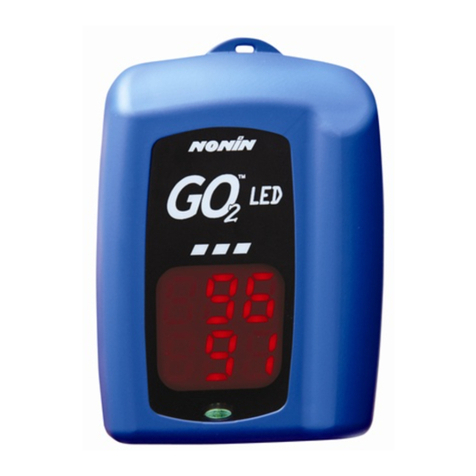
Nonin
Nonin 9571 Go2 LED User manual
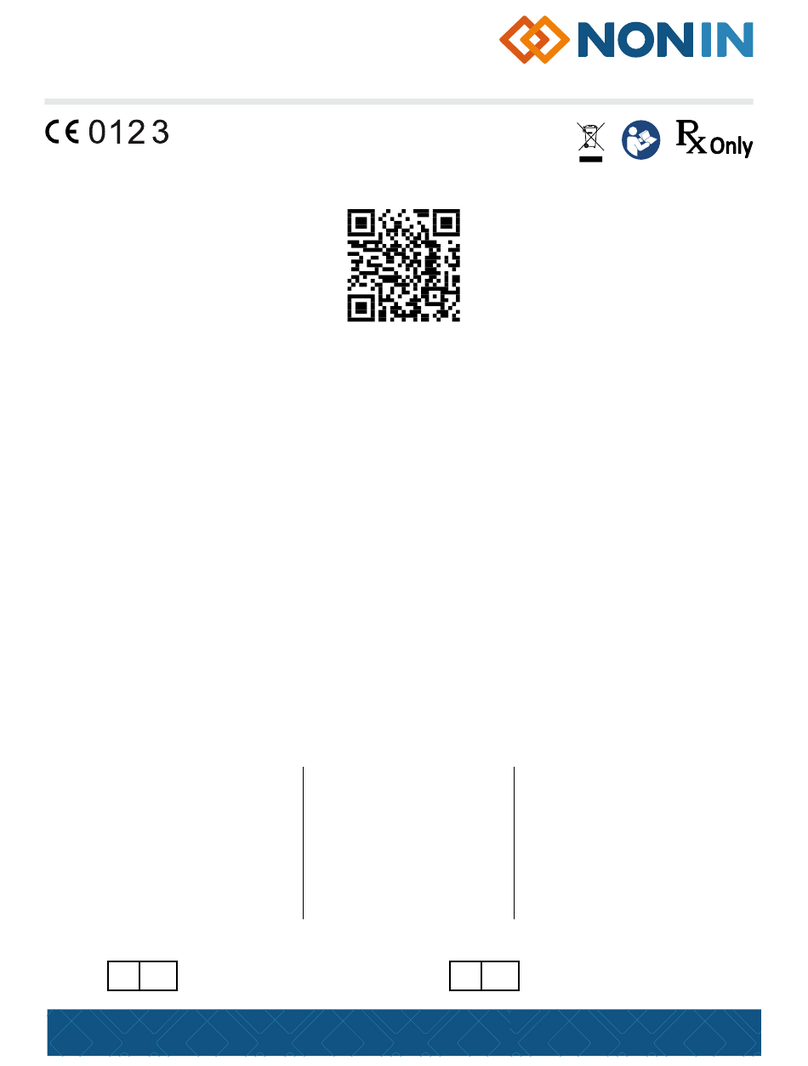
Nonin
Nonin 2500 PalmSAT User manual
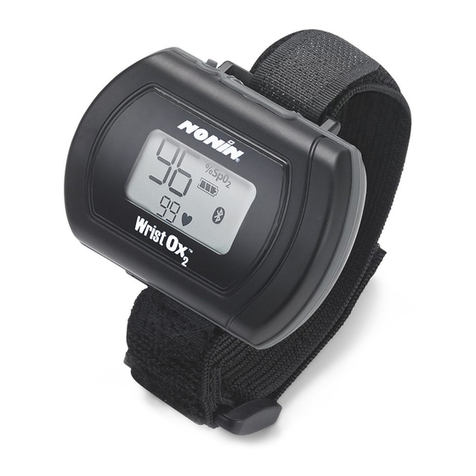
Nonin
Nonin WristOx2 3150 User manual
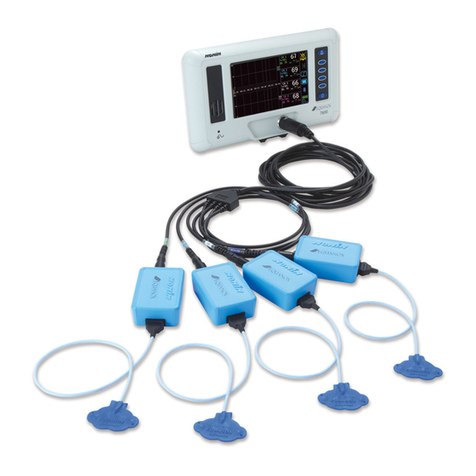
Nonin
Nonin 7600 User manual

Nonin
Nonin 8600 User manual
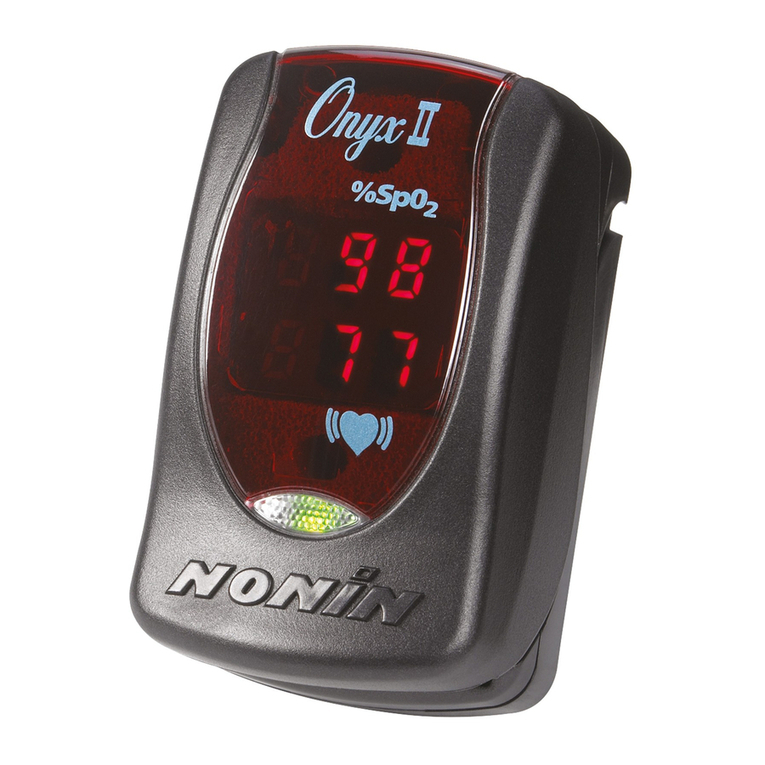
Nonin
Nonin Onyx II 9550 Manual
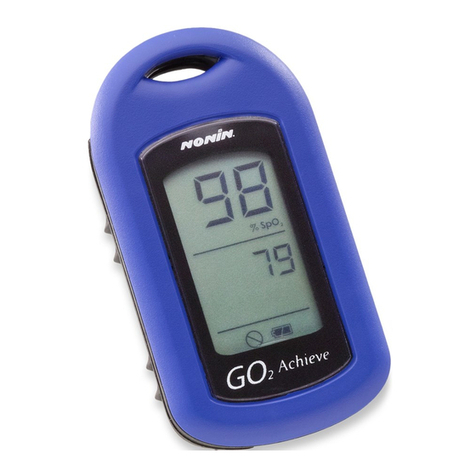
Nonin
Nonin GO2 Achieve User manual

Nonin
Nonin 7500FO User manual
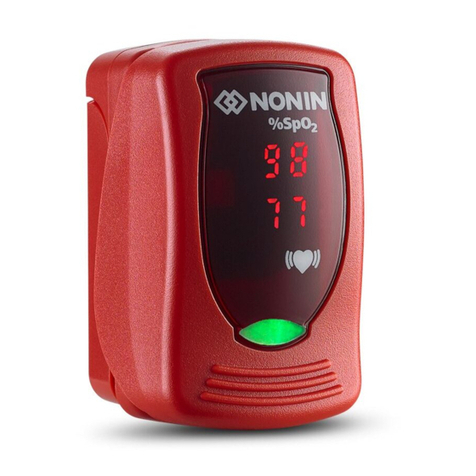
Nonin
Nonin Onyx Vantage 9590 User manual
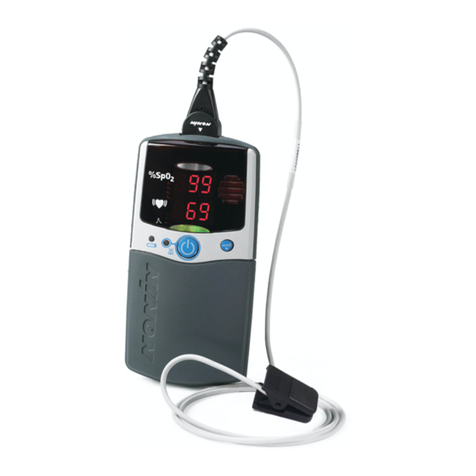
Nonin
Nonin 2500A PalmSAT User manual

Nonin
Nonin Onyx II 9550 User manual
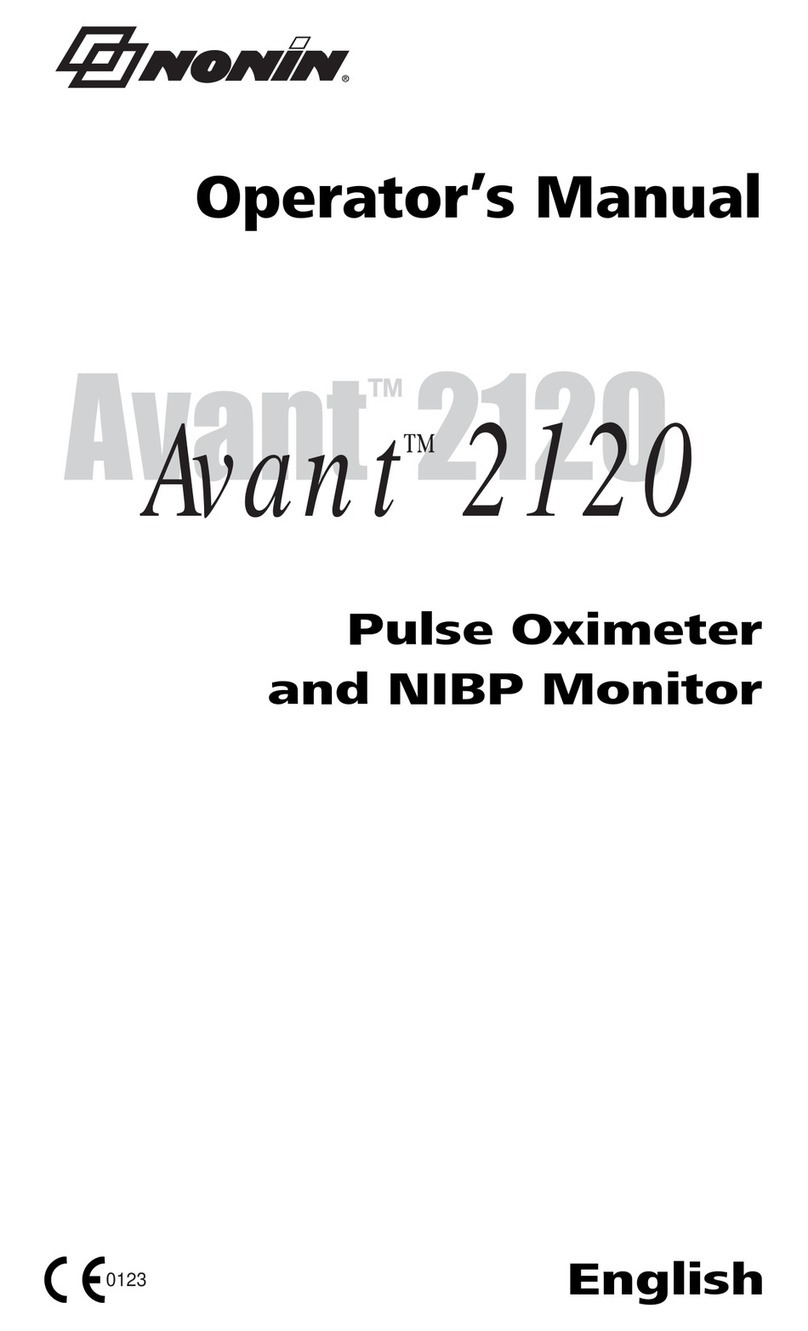
Nonin
Nonin 2120 User manual
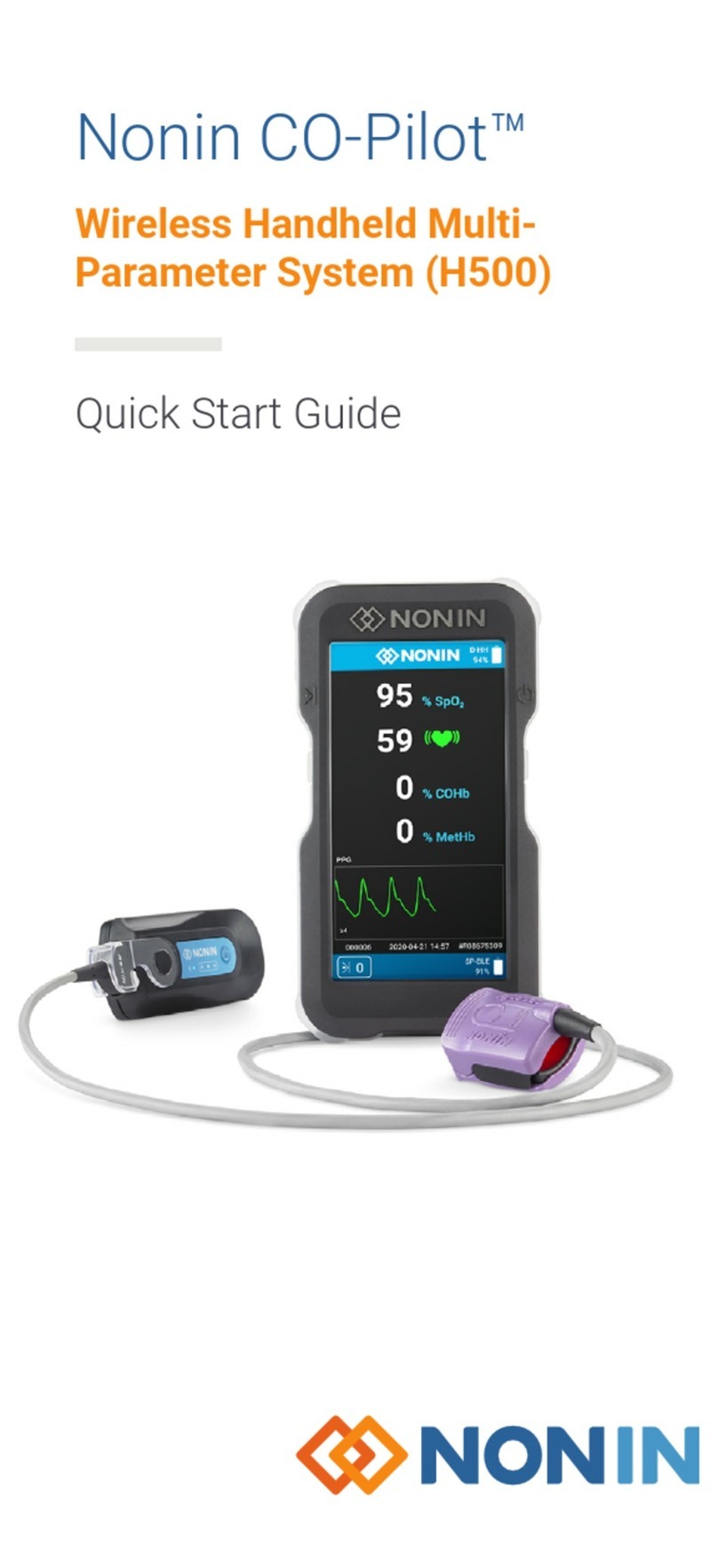
Nonin
Nonin CO-Pilot H500 User manual

Nonin
Nonin Avant 4000 User manual
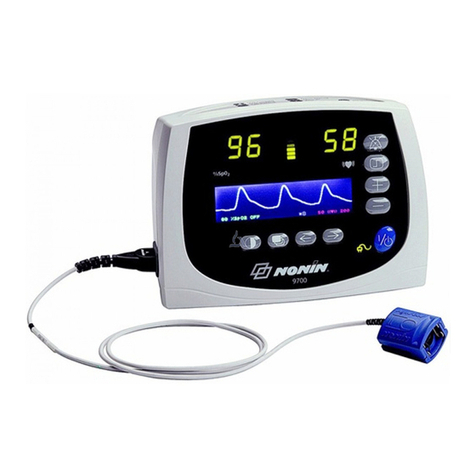
Nonin
Nonin Avant 9700 User manual

Nonin
Nonin Onyx Vantage 9590 User manual

Nonin
Nonin 3100 WristOx User manual

Nonin
Nonin 8600V User manual

Nonin
Nonin 2120 User manual
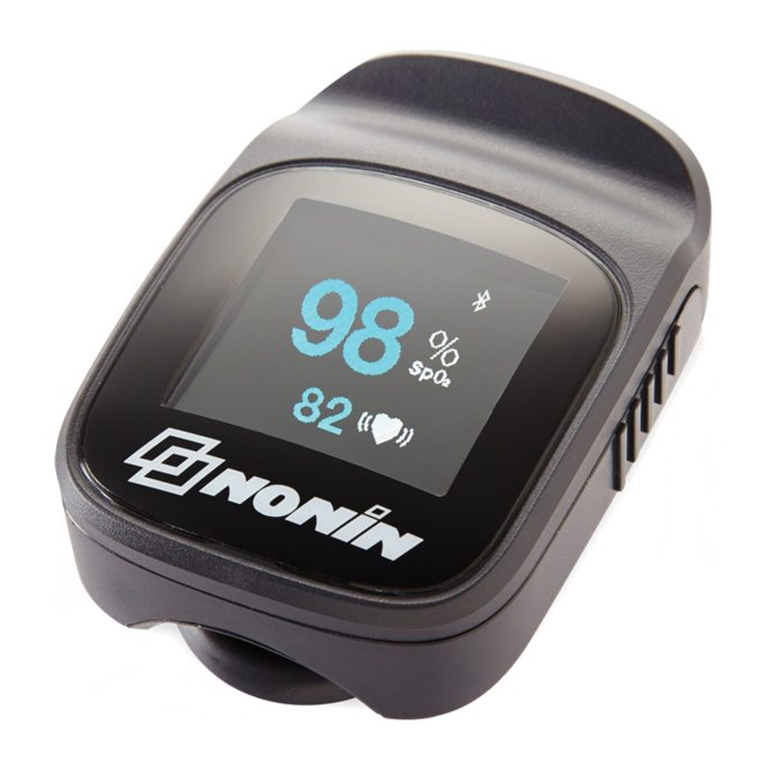
Nonin
Nonin 3230 User manual

